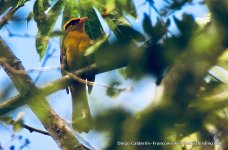Katy Penland said:
I guess distilled down to its essence, my objection to "collection" is science's need for information at the expense of an animal's life when science itself can't quantify or qualify what the definition of species is, with or without skins in hand. Is it really rational to continue killing animals for "museum specimens" when scientists can't agree on what constitutes a species? All of the salient points of your "species concept" and Niels' pipit observations just point up the fallibility of a profession constantly in flux (because what it studies is in constant evolutionary flux). I'm not saying that science and its methods must be perfect; of course not -- but I do think it's unscientific and unethical to kill something about which virtually nothing is known and particularly where no effort has been made to study it alive first in its natural habitat. "
I do believe that your view of the current dispute over what a species is, is more pessimistic than mine. We all agree, that if two populations coexist without (or at least only with rare hybrids occurring), than the two populations are different species. The entire dispute arises over populations in which the natural experiment does not happen: in other words if there is no known place in which the two populations overlap. There has for a lot of years been a standard saying that if the morphology differed in a sufficient number of characters, then it was believed that the two populations were different species. Among the characters used were shape of bones, and other things that cannot be measured completely on a live bird; I think that is one reason that the traditional museum crowd have had a hard time with DNA based phylogeny replacing skins in those cases where populations are very small. My pipit example was meant to show not necessarily a fallacy of one or the other method; rather I used it to show the equivalency of the two methods. I completely agree with Rasmus's comment that as two populations are separated through an increasing amount of time they become increasingly more different, and the chance that they do not interbreed successfully if brought together also increases. There is no mathematical formula that with complete confidence can tell us how many differences have to be accumulated before two populations are different species. In the absence of the natural experiment, we have to argue about the status of difficult pairs, and that is not likely to ever change.
I do believe that Rasmus have argued as to why there is a rush for data in at least some places: all those places where a population is confined to one valley, and the powers that be want to build a dam for water-power; or where a government want to introduce logging into the last untouched forests because the profit for the logging companies is larger when they don’t have to own the land or make sure to replant their own land to harvest trees again in 60 years. In those cases, having the ability to say that there is a species found no other place that will perish is a stronger argument than if the argument only is able to say we know there is a population and we dont know the status of it, but it is somewhat different looking from what we see elsewhere.
I would like to repeat my proposal that for those populations that are too sparse to risk collecting even one bird, mist-netting with photos and DNA based species description is a very valid alternative. I believe if someone have time, the way to raise money is by sponsorship from an optics company: write for example to Zeiss/Contax, promise them that on the expedition only their binoculars and cameras will be used, and promise that immediately upon the return they will be given access to a photo of the bird so that they can have the sole web-accessible picture for at least one year. Of course, it is necessary to include an explanation that a mishap might cause the expedition to not capture the bird anyway. Also sell the expedition with the argument that the bird will not be collected, so that there will be some feel good factor to use in marketing.
I think that the above can be a valid way to get information on the birds that are very scarce. For less scarce populations, I do agree with Rasmus that collecting a type specimen is not the end of the world.
All the best
Niels








